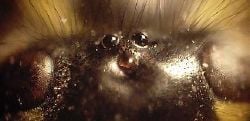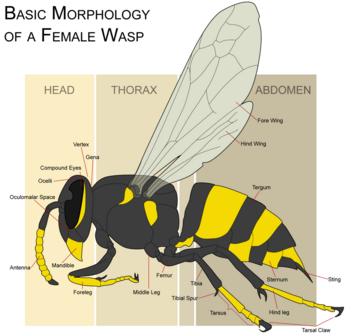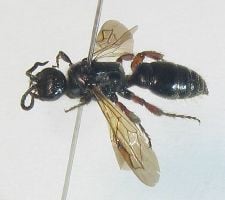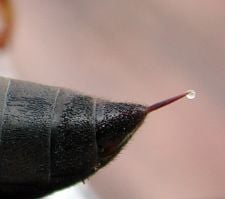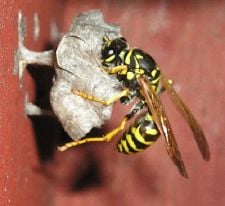Wasp
| Wasps | ||||||||
|---|---|---|---|---|---|---|---|---|
 Aleiodes indiscretus
parasitizing a gypsy moth caterpillar | ||||||||
| Scientific classification | ||||||||
| ||||||||
|
Apocrita |
Broadly defined, wasp is any insect of the order Hymenoptera and suborder Apocrita that is not a bee or ant. This includes more than 20,000 known species. A narrower but popular definition of the term is any member of the Aculeate family Vespidae, which includes (among others) the paper wasps, potter wasps, hornets, pollen wasps, and yellowjackets.
Although wasps often are viewed as domestic nuisances or as dangers due to their stingers, in reality they provide a value function for the ecosystem and for human beings. Ecologically, they are important in food chains. Agriculturally, they offer a natural biocontrol of agricultural pests, since so many wasp species are parasites or predators of pest species. In addition, the diversity of wasps adds to the wonder of nature for humans.
Overview
Wasp are members of Hymenoptera, one of the largest orders of insects with at least 100,000 described species. As arthropods, wasps are characterized by jointed appendages, an exoskeleton (hard, external covering), segmented body, ventral nervous system, digestive system, open circulatory system, and specialized sensory receptors. The term "jointed appendages" refers to both legs and antennae. As insects, wasps are characterized by three pairs of jointed legs; an abdomen that is divided into 11 segments and lacks any legs or wings; and a body separated into three parts (head, thorax, and abdomen), with one pair of antennae on the head. As true insects, they also have ectognathous, or exposed, mouthparts.
Hymenopterans are placed into two suborders: Apocrita and Symphyta. The wasps, bees, and ants together make up the suborder Apocrita, characterized by a constriction between the first and second abdominal segments called a wasp-waist (petiole), also involving the fusion of the first abdominal segment to the thorax. In suborder Symphyta, (sawflies, horntails, and wood wasps), there is a broad connection between the abdomen and the thorax.
Larva of wasps, like all Apocrita, do not have legs, prolegs, or ocelli. Symphyta larvae are mostly herbivorous and "caterpillarlike," whereas those of Apocrita are largely predatory or "parasitic" (technically known as parasitoid).
The most familiar wasps belong to Aculeata, a division of Apocrita, whose ovipositors (an organ typically used for laying eggs) are adapted into a venomous stinger. Aculeata is one of two common groupings of the Aprocrita. The other is Parasitica, the term used for four superfamilies of AprocritaâIchneumonoidea, Chalcidoidea, Cynipoidea, and Proctotrupoidea (Grzimek et al. 2004). The Aculeata make up the remaining superfamilies. While the Parasitica tend to be parasites of other insects, and the Aculeata are stinging forms, in reality some Parasitca are phytophagous and many Aculeata (particularly wasps) are parasites (Grzimek et al. 2004). Aculeata also contains ants and bees.
Description
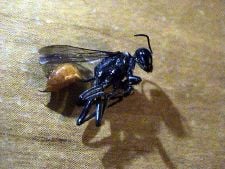
Anatomically, there is a great deal of variation between different species of wasp. Like all insects, wasps have a hard exoskeleton covering their three main body parts. These parts are known as the head, metasoma, and mesosoma. Wasps also have a constricted region (the petiole) joining the first and second segments of the abdomen (the first segment is part of the mesosoma, the second is part of the metasoma). In addition to their compound eyes, wasps also have several simple eyes known as ocelli. These are typically arranged in a triangular formation just forward of an area of the head known as the vertex.
Wasps can be differentiated from bees as the latter have a flattened hind basitarsus. Unlike bees, wasps generally lack plumose hairs. They vary in the number and size of hairs they have between species.
The following characteristics are present in most wasps:
- two pairs of wings (except all female Mutillidae, Bradynobaenidae, many male Agaonidae, many female Ichneumonidae, Braconidae, Tiphiidae, Scelionidae, Rhopalosomatidae, Eupelmidae, and various other families).
- An ovipositor, or stinger (which is only present in females because it derives from the ovipositor, a female sex organ).
- Few or no hairs (in contrast to bees); except Mutillidae, Bradynobaenidae, Scoliidae.
- Nearly all wasps are terrestrial; only a few specialized parasitic groups are aquatic.
- Predators or parasitoids, mostly on other terrestrial insects; some species of Pompilidae, such as the tarantula hawk, specialize in using spiders as prey, and various parasitic wasps use spiders or other arachnids as reproductive hosts.
It is possible to distinguish between certain wasp species genders based on the number of divisions on their antennae. Male yellowjacket wasps, for example, have 13 divisions per antenna, while females have 12. Males can in some cases be differentiated from females by virtue of the fact that the upper region of the male's mesosoma (called the tergum) consists of an additional terga. The total number of terga is typically six. The difference between sterile female worker wasps and queens also varies between species but generally the queen is noticeably larger than both males and other females.
Wasps are holometabolus insects, meaning they undergo complete metamorphosis in which the larvae differ markedly from the adults. Insects that undergo holometabolism pass through a larval stage, then enter an inactive state called pupa, and finally emerge as adults (imago).
In wasps, as in other Hymenoptera, sexes are significantly genetically different. Females have a diploid (2n) number of chromosomes and come about from fertilized eggs. Males, in contrast, have a haploid (n) number of chromosomes and develop from an unfertilized egg.
Behavior
Wasps may be solitary or may live in various types of communities. Most of the more than 20,000 species of wasps are solitary. Adult solitary wasps generally live and operate alone and many do not construct nests, and all adult solitary wasps are fertile. By contrast, social wasps exist in colonies numbering up to several thousand strong, build a nest, and in some cases not all of the colony can reproduce. The family of "true wasps," Vespidae, includes both social and solitary forms. Paper wasps, hornets, and yellow jackets are examples of social forms, while potter wasps are an example of a solitary wasp.
There are different levels of sociality. In some species of hymenoptera, groups of cohabiting females may be sisters, and if there is a division of labor within the group, then they are considered semisocial. The most advanced of the social communities are eusocial colonies. In these, in addition to a division of labor, the group consists of a mother and her daughters. Such eusocial colonies can be primitively social or highly social. If the castes are purely behavioral alternatives, the system is considered "primitively eusocial," and if the castes are morphologically discrete, then the system is "highly eusocial." Paper wasps exhibit primative eusociality. About 1,000 species of wasps are highly eusocial hymenopterans.
Generally wasps are carnivorous in some stage, feeding on insects, worms, spiders, and so forth. Some wasps are omnivorous, feeding on a variety of fallen fruit, nectar and carrion. Certain social wasp species, such as yellowjackets, scavenge for dead insects to provide for their young. In turn, the brood provides sweet secretions for the adults.
Wasps include both free-living and parasitic species. The larva of many wasp are parasitoids that are parasites in the immature stages of other animals, but the adults are free living. The adults of these species lay their eggs in or on the host animal to develop. In parasitic species, the first meals are almost always provided from the animal the adult wasp used as a host for its young.
With most species, adult parasitic wasps themselves do not take any nutrients from their prey, and, much like bees, butterflies, and moths, they typically derive all of their nutrition from nectar. Parasitic wasps are very diverse in habits, many laying their eggs in inert stages of their host (egg or pupa), or sometimes paralyzing their prey by injecting it with venom through their ovipositor. They, then inject the host with eggs or deposit them upon the host externally. When the eggs hatch, the larvae eat the prey, which provides them with a first meal. After this point, most wasps must obtain their own food and fend for themselves.
Social wasp reproductive cycle
Among highly eusocial wasps, there are typically three castes: the queens (which lay the eggs), the workers (which are sexually undeveloped females), and the drones (the males, for reproduction).
Social wasps reproduce between a fertile queen and male wasp; in some cases, queens may be fertilized by the sperm of several males. After successfully mating, the male's sperm cells are stored in a tightly packed ball inside the queen. The sperm cells are kept stored in a dormant state until they are needed the following spring. Wasps do not reproduce via mating flights like bees.
In temperate zones, at a certain time of year (often around autumn), the bulk of the wasp colony dies away, leaving only the young mated queens alive. During this time they leave the nest and find a suitable area to hibernate for the winter. In tropical areas, the colony may continue but divides into new colonies when it becomes large.
The following is a scenario for a temperate zone, eusocial wasp colony.
After emerging from hibernation during early spring, the young queens search for a suitable nesting site. Upon finding an area for their future colony, the queen constructs a basic paper fiber nest roughly the size of a walnut into which she will begin to lay eggs.
The sperm that were stored earlier and kept dormant over winter is now used to fertilize the eggs being laid. The storage of sperm inside the female queen allows her to lay a considerable number of fertilized eggs without the need for repeated mating with a male wasp. For this reason, a single female queen is capable of building an entire colony from only herself. The queen initially raises the first several sets of wasp eggs until enough sterile female workers exist to maintain the offspring without her assistance. All of the eggs produced at this time are sterile female workers which will begin to construct a more elaborate nest around their queen as they grow in number. The social wasp adult feeds chiefly on plant sources (nectar and sap), but the larvae are raised on animal food that is masticated.
By this time, the nest size has expanded considerably and now numbers between several hundred and several thousand wasps. Towards the end of the summer, the queen begins to run out of stored sperm to fertilize more eggs. These eggs develop into fertile males and fertile female queens. The male drones then fly out of the nest and find a mate thus perpetuating the wasp reproductive cycle. In most species of social wasps, the young queens mate in the vicinity of their home nest and do not travel like their male counterparts do. The young queens will then leave the colony to hibernate for the winter once the other worker wasps and founder queen have started to die off. After successfully mating with a young queen, the male drones die off as well. Generally, young queens and drones from the same nest do not mate with each other, this ensures more genetic variation within wasp populations, especially considering that all members of the colony are theoretically the direct genetic descendants of the founder queen and a single male drone. In practice, however, colonies can sometimes consist of the offspring of several male drones. Wasp queens generally (but not always) create new nests each year, this is probably because the weak construction of most nests render them uninhabitable after the winter.
Unlike most honeybee queens, wasp queens typically only live for one year (although exceptions are possible). Also, contrary to popular belief, queen wasps do not organize their colony or have any raised status and hierarchical power within the social structure. They are more simply the reproductive element of the colony and the initial builder of the nest in those species which construct nests.
Wasp caste structure
Not all social wasps operate a caste structure of permanent queens, males, and sterile female workers. Paper wasps, for example, consist solely of male and female wasps. All female wasps are capable of becoming the colony's queen and this process is determined by which female worker successfully lays eggs first and begins construction of the nest.
Evidence suggests that females compete among each other by eating the eggs of other rival females. In such cases, the queen is the wasp that can eat the most other eggs while ensuring her own survive (often achieved by laying the most). This process theoretically determines the strongest and most reproductively capable female and selects her as the queen.
Once the first eggs have hatched, the female workers stop laying eggs and instead forage for the new queen and feed the young. Paper wasp nests are considerably smaller than many other social wasp nests, housing only around 250 wasps, compared to the several thousand common with yellowjackets.
Nesting habits
The type of nest produced by wasps can depend on the species and location. All social wasps produce paper pulp nests on trees, in attics, holes in the ground, or other such sheltered areas with access to the outdoors. By contrast, species of solitary wasps often do not build nests at all, although they may construct a small hole, which is dug by the female, and the potter wasps make their nests of mud, fixed to plants. Unlike honeybees, wasps have no wax producing glands. They instead produce a paper-like substance primarily from wood pulp. Wood fibers are gathered locally from weathered wood, softened by chewing and mixing with saliva. The pulp then is used to make combs with cells for brood rearing.
Solitary wasps
The nesting habits of solitary wasps are as diverse as those of social wasps. Mud daubers construct mud cells in sheltered places typically on the side of walls. Potter wasps, by contrast, build vase-like cells from clay attached to the twigs of trees. Digger wasps burrow into soil and then tap down the earth around the brooding chamber with pebbles to fill the mouth of the burrow, protecting it from both the elements and predators. Most solitary wasps do not build nests at all and prefer naturally occurring shelter, such as small holes in wood.
Social wasps
The nests of some social wasps, such as hornets, are first constructed by the queen and reach about the size of a walnut before sterile female workers take over construction. The queen initially starts the nest by making a single layer or canopy and working outwards until she reaches the edges of the cavity. Beneath the canopy she constructs a stalk to which she can attach several cells; these cells are where the first eggs will be laid. The queen then continues to work outwards to the edges of the cavity after which she adds another tier. This process is repeated, each time adding a new tier until eventually (around July in Europe) enough female workers have been born and matured to take over construction of the nest, leaving the queen to focus on reproduction. For this reason, the size of a nest is generally a good indicator of approximately how many female workers there are in the colony. Social wasp colonies often have populations exceeding several thousand female workers and at least one queen. Paper wasps (a variety of social wasp) do not construct their nests in tiers but rather in flat single combs.
Importance
Wasps are important in food chains. In addition, wasps are critically important in natural biocontrol. Almost every pest insect species has a wasp species that is a predator or parasite upon it. Parasitic wasps are also increasingly used in agricultural pest control as they have little impact on crops.
Common families
- Agaonidae - fig wasps
- Chalcididae
- Chrysididae - cuckoo wasps
- Crabronidae - sand wasps and relatives, e.g. the Cicada killer wasp
- Cynipidae - gall wasps
- Encyrtidae
- Eulophidae
- Eupelmidae
- Ichneumonidae, and Braconidae
- Mutillidae - velvet ants
- Mymaridae - fairyflies
- Pompilidae - spider wasps
- Pteromalidae
- Scelionidae
- Scoliidae - scoliid wasps
- Sphecidae - digger wasps
- Tiphiidae - flower wasps
- Torymidae
- Trichogrammatidae
- Vespidae - yellowjackets, hornets, paper wasps, mason wasps
ReferencesISBN links support NWE through referral fees
- Grimaldi, D., and M. S. Engel. 2005. Evolution of the Insects. Cambridge University Press. ISBN 0521821495.
- Grzimek, B., D. G. Kleiman, V. Geist, and M. C. McDade. 2004. Grzimek's Animal Life Encyclopedia. Detroit: Thomson-Gale. ISBN 0787657883
- Ross, K. G., and R. W. Matthews. 1991. The Social Biology of Wasps. Ithaca: Comstock Pub. Associates. ISBN 0801420350
External links
All links retrieved May 3, 2023.
Credits
New World Encyclopedia writers and editors rewrote and completed the Wikipedia article in accordance with New World Encyclopedia standards. This article abides by terms of the Creative Commons CC-by-sa 3.0 License (CC-by-sa), which may be used and disseminated with proper attribution. Credit is due under the terms of this license that can reference both the New World Encyclopedia contributors and the selfless volunteer contributors of the Wikimedia Foundation. To cite this article click here for a list of acceptable citing formats.The history of earlier contributions by wikipedians is accessible to researchers here:
The history of this article since it was imported to New World Encyclopedia:
Note: Some restrictions may apply to use of individual images which are separately licensed.
